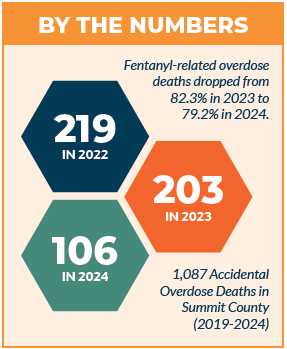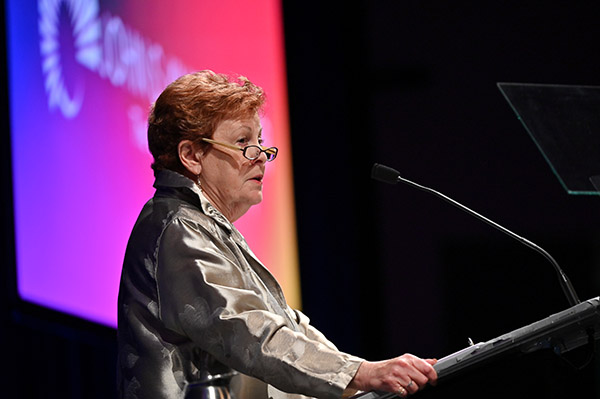Urgent Crisis, Enduring Change: Supporting Organization Targets Health Crisis
By Chris Miller, Communications & Community Investment Officer

Amid a nationwide epidemic, Summit County remains deeply impacted by one of the most pressing public health and safety challenges of our time. As of June 30, 2025, the county has recorded 487 suspected overdoses this year – an average of more than two each day.
Fifty-two of them have been fatal.
The numbers are tragic, but they're not just numbers. They represent lives lost, families shattered, and communities reeling from a crisis fueled by prescription opioids and compounded by newer, more complex threats. Increasingly, these overdoses involve multiple substances – fentanyl mixed with meth, alcohol laced with cocaine – combinations that make treatment increasingly more complicated. These polysubstance overdoses have become a leading concern for public health professionals. They often require specialized "dual diagnosis" care – treatment that addresses both substance use and underlying mental health conditions, according to Donna Skoda, recently retired health commissioner for Summit County.
Add to this the stigma that addiction carries: Many people still view addiction as a moral failing rather than a diagnosable disease. There's also a misconception that treatment and recovery are "one size fits all."
Yet even in the face of these grim realities, there is hope. And it's coming in the form of one of the largest single investments in Summit County's public health and safety history.
A Groundbreaking Settlement
When Summit County Executive Ilene Shapiro joined a federal lawsuit against prescription drug manufacturers, she never expected the county to receive a penny. Not only was Summit County awarded a settlement, but it became a bellwether for legal cases across the country. It placed the county at the forefront of a systemic remediation to the devastating role prescription narcotics have played in a national health crisis.
The initial federal court settlement led to Summit and Cuyahoga counties reaching agreements in principle with drugmaker Teva Pharmaceuticals and drug distributors AmerisourceBergen, Cardinal Health and McKesson. Per the proposed settlement agreements, Teva was ordered to pay $20 million in cash and provide $25 million worth of addiction treatment drugs to the two counties, while AmerisourceBergen, Cardinal Health and McKesson were required to pay a combined $215 million in cash. Summit and Cuyahoga counties split the settlements at 38% and 62%, respectively.
Thanks to that initial settlement, a $45 million investment will be used to establish the Summit Health and Safety Innovation Fund at Akron Community Foundation. The fund will operate as a separate, tax-exempt, charitable organization of Akron Community Foundation known as a supporting organization.
"When we first received the settlement funds, I had three goals," Shapiro said. "First, to get money out into the community to stop overdoses and enhance pathways to treatment and recovery. Second, to purchase a software platform that would allow providers and other stakeholders to better coordinate care for those with substance use disorder and reduce barriers to accessing care. Today, the Unite Us platform is free to any community organization in Summit County. Finally, I wanted to identify a mechanism that would allow a portion of the funds to be available in perpetuity to fund innovative programming that could address the health and safety issues of today, but also whatever challenges await us in the future."
A Unique Arrangement
According to the IRS, a supporting organization's classification as a nonprofit is unique in that it is a distinct legal entity, but it relies on its relationship with a public charity, often a community foundation, hospital or university. A local example of a supporting organization is the Barberton Community Foundation, which was established using proceeds from the sale of the former Barberton Citizens Hospital and is a supporting organization of the City of Barberton and the Barberton City School District.
The creation of a supporting organization will enable the Summit Health and Safety Innovation Fund to have maximum community impact: The fund will be permanently endowed and invested according to an investment policy that may mirror Akron Community Foundation's, but it will exist as its own Ohio nonprofit corporation. The fund will also have its own governing board of directors charged with management of the organization and grantmaking, among other responsibilities.

"In establishing the supporting organization, we expect three outcomes," Shapiro said. "First, it will support innovative approaches to health and safety by providing startup funding for good ideas that need legs to get off the ground. Second, it will act as a convener to attract sustained funding for proven ideas. Finally, it will have the flexibility to respond to whatever health and safety issues emerge in Summit County. Today it is opioids; tomorrow it could be something completely different."
The decision to partner with Akron Community Foundation and create this organizational structure was made after thorough research. "After investigating our options, we identified the supporting organization structure," Shapiro said. "It was a no-brainer to ask Akron Community Foundation to host it. Having served as a board member and been a witness to the impact of this organization, I knew the community foundation was well-suited to help us make it a reality."
"Akron Community Foundation's role has always been to connect resources with community needs," said John T. Petures Jr., former president and CEO of Akron Community Foundation. "By housing this fund, we're helping to ensure that settlement dollars stay local, support innovation, and adapt to the evolving health and safety challenges facing Summit County for generations to come."
The fund is more than a financial vehicle – it's part of a larger ecosystem of support in Summit County, which is home to a wide network of community-based recovery organizations. "Akron is the birthplace of Alcoholics Anonymous and is very fortunate to have a variety of self-help groups, anonymous support groups, and community-based organizations," Skoda said. "In addition, there is a web of peer support, grassroots and nonprofit agencies focused on both substance use and mental health support. Peer supporters are people with lived experience of substance use or mental health concerns who have found their own recovery and now use their experience to help others."
Peers, she said, can get specialized education and training to be licensed through the Ohio Department of Mental Health and Addiction Services, offering a vital avenue for people in recovery to connect in ways they can't with clinicians and doctors. In addition, Skoda said, "Many grassroots and nonprofit organizations in Summit County also provide support not just for those struggling, but for their children and families, offering opportunities and resources for healing that spread far beyond the individual."
Legal Win Sparks Community Investments
This isn't the county's first collaboration with Akron Community Foundation. Following the settlement, Shapiro and a group of stakeholders, including Akron Mayor Shammas Malik and Summit County Public Health, helped assemble the Opiate Abatement Advisory Council, which provides oversight to ensure funding from the settlement goes to Summit County programs that help to abate the opioid epidemic by addressing four priority areas: Harm Reduction, System Coordination, Evidence-Based Prevention and Education.
In 2021, the OAAC established the Summit County Opioid Healing Fund at Akron Community Foundation, which has distributed more than $1.2 million in grants – up to $25,000 each – for peer support services, recovery events and community education.
In total, the OAAC has deployed nearly $16 million in opioid settlement funds, but the supporting organization takes those efforts a step further – it's a permanent, community-led strategy for the long haul.
The Summit Health and Safety Innovation Fund was approved by Summit County Council in December 2024 and is estimated to be fully established and funded with the initial $45 million investment at Akron Community Foundation by the end of 2025. In addition, the county approved the creation of a separate $5 million fund at the community foundation to specifically support programs that address the significant health and safety issues faced by minority and disadvantaged residents in Summit County.
Once in operation, the supporting organization will likely generate more than $1 million in funding for nonprofits in the community each year – resources that weren't available before.
"This isn't just about responding to a crisis," Petures said. "It's about creating the kind of community where prevention is possible, treatment is accessible, and innovation thrives."
A silver lining to a heinous epidemic, it's a chance to heal some of the damage done in neighborhoods across Summit County.
To stay up to date on developments with the Summit Health and Safety Innovation Fund, visit akroncf.org/SummitHealthFund.
